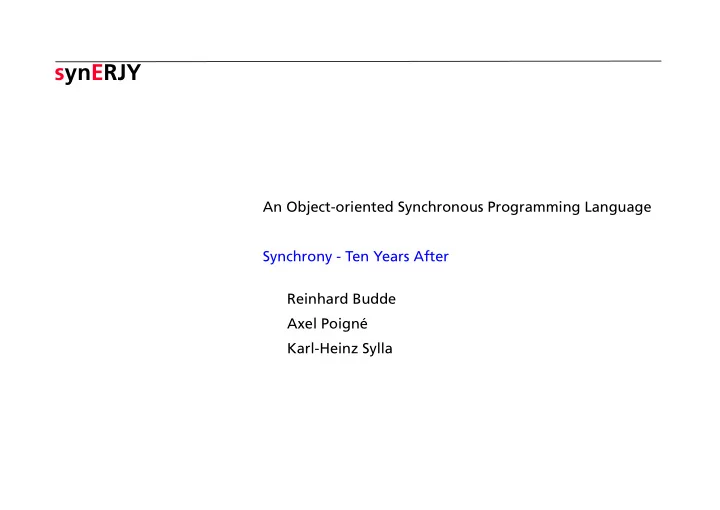

synERJY An Object-oriented Synchronous Programming Language Synchrony - Ten Years After Reinhard Budde Axel Poigné Karl-Heinz Sylla
Overview • Highlights • Reactive Components • Synchronous Styles • Hybrid Systems • Semantics • Programming Environment • Conclusions & Outlook page
Highlights • supports object-oriented design (using a Java-like language) • integrates synchronous styles • targets micro controllers page
interface to Reactive Components class Basic { environment static final time timing = 250msec; read only Sensor button = new Sensor(new SimInput()); Signal red_led = new Signal(new SimOutput()); public Basic () { active { loop { await ?button; emit red_led; next; }; }; }; public static void main (String[] args) { while (instant() == 0) {}; }; } page
Reactive Compents II System Environment Signals Signal bus Components = Objects page
Synchronous Styles • Imperative (Esterel - like) • Data Flow (Lustre - like) • Hierarchical State Machines (Statecharts - like) page
Synchronous Styles: Imperative Style - Syntax Types Sensor , Sensor < type > type = primitive, restricted reference Signal , Signal < type > DelayedSignal , DelayedSignal <type> time Statements emit s; , emit s(v); assignment ; method_call ; if reactive = module next; await expr ; await time_expr ; cancel { } when () else when … activate { } when (); loop { }; if ( ) { } else { }; [[ || || ]] parallel page
Synchronous Styles: Imperative Style - New Features Time Races Restricted to classes [[... data-op1 ...||... data-op2 ...]] (attributes and methods are private) Resolved using precedence precedence { data-op1 < data-op2; }; page
New Features Continued Multiple Emittance no combinators [[... emit s(v1); ...||... emit s(v2); ...]]; Either avoid or use labels and precedence [[... l1::emit s(v1); ...||... l2::emit s(v2); ...]]; precedence { l1:: < l2:: ; }; page
Synchronous Styles: Data Flow flow context sustain {| x := pre(x) + 1; |}; • handled like any other statement (can be preempted) • flow expressions with all the Lustre operator • clocks page
Interrupt: Concerning Java All compiled to C ¬ Dynamic Loading (HW formats) ¬ No packages (yet ?) ¬ Exception Handling only top level ¬ No Hiding (for good software) ¬ Only one- and two-dimensional arrays (for efficiency) ¬ Semicolon “;” is a must as terminator + more integer types: int8, unint8,…, uint64, int64 + native C (constants and functions) + Parametrised Types “ List<T> ” page
Hybrid Systems: Bouncing Ball x1 <= 0 / x2 = -x2 x1 = x2 x1 > 0 x2 = -g x1 = x2 Change direction x2 = -g if x1 <= 0 page
Bouncing Ball II automaton { init { emit x1(height); emit x2(0.0); change of direction next state move; }; state move during {| x1 := pre(x1) + x2*dt; x2 := -c*pre(x2) -> pre(x2) - g *dt; |} when ($x1 <= 0.0) { next state move; }; }; • pre and -> are defined relative to flow context page
Semantics: Signals • all Signals have a clock • Signals are present if updated • Signals may be updated using - emit Statement - flow equation: then clocks are checked • Signals that are emitted are always on base clocks • Clocks are part of a Signal type: Signal{ clock }< type > (Signal< type > = Signal{true}< type >) page
Semantics: Translation Scheme (Model of 93/98) “beta” “front” preemption α β τ µ flow context synchronous s <= φ automaton r <- φ (Semantic Domain) if s { a; }; • Semantics is “compositional” ω • Realisation as denotational κ semantics in ocaml control termination page
Translation Scheme Example s <= α ; s <= α ; a1 <= α ; a1 <= α ; if (a1) { $s = v1; }; if (a1) { $s = v1; }; ω <= α | CC(a1); γ <= α | CC(a1) emit s(v1); f(v2); a2 <= γ ; a2 <= α ; if (a2) { f(v2}; }; if (a2) { f(v2}; }; ω <= γ | CC(a2) ω <= α | CC(a2); page
Programming Environment synERJY light HW-Formate Windows ARM CAN TTA Linux PIC Compiler synERJY MPC555 ANSII - C RT-Linux ATMEL Mac OSX DSP Simulink Simulink FPGA . . . LEGO-Lib ATMEL-Lib CAN-Lib F4-Lib page
Conclusions • Language is stable / compiler reasonably mature • Usage - Teaching - Robotics Applications - Project on smart materials • Experience is somewhat annoying - people use only one style (imperative / state-machines), and - encode their standard programming style page
Outlook • allow several reactive engines (several calls of instant ) • Support for Digital Signal Processing • Generate Code for DSP (more long term: FPGA) • Optimisation of the compiler with regard to different targets • Minor Points: add functional nodes, improve simulator, ... page
Recommend
More recommend